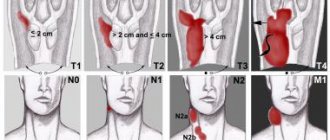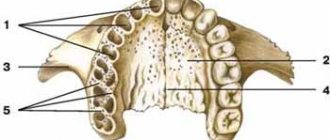Speech is a complex motor skill implemented by a large number of anatomical structures. The structure of the human vocal apparatus includes the organs of the respiratory system, larynx, tongue, teeth, etc. If the integrity of any of them is violated, the sound production process is disrupted. Knowledge of the anatomical structure and operating principle of the articulatory organs is important not only for singers or other professions related to music, but also for ordinary people. Speech disorders can occur in both children and adults, leading to disruption of the processes of social adaptation and learning.
Causes of pharyngeal cancer
The following are the main causes of throat cancer:
| Causes | Description |
| Smoking | Tobacco products containing harmful substances contribute to the development of the disease |
| Alcohol | Alcohol-containing products weaken the body and damage the immune system if abused. |
| Lack of oral hygiene | Lack of care and hygiene increases the risk of developing throat cancer |
| Heredity | If there are people in your family with throat cancer, the likelihood of it occurring in the future generation increases |
| papillomavirus | Infection increases the likelihood of developing cancer. |
How much do you have to smoke to get throat cancer? Studies conducted by scientists have found a connection between the number of cigarettes smoked per day, smoking experience and the likelihood of throat cancer. The higher the first 2 indicators, the higher the risk of cancer. Other forms of tobacco use also increase risk. There is a potential risk of laryngeal cancer in both smokers and those who chew tobacco. In individuals who have both of these habits, the risk of developing throat cancer increases by 3-4 times. Excessive consumption of strong alcoholic beverages is the first reason that increases the risk of developing the disease.
Laryngeal cancer associated with human papillomavirus has characteristic biological features. In its treatment, less aggressive organ-preserving chemotherapy regimens are used. How long does it take for throat cancer to develop? The process of transformation of normal cells into atypical ones is individual for each person. Throat cancer does not develop immediately. It is preceded by long-term precancerous diseases:
- Dyskeratoses of the larynx (leukoplakia, leukokeratosis);
- Pachydermia;
- Fibroma;
- Papillomas;
- Cysts;
- Chronic inflammatory processes in the larynx, which are accompanied by frequent alcohol consumption and smoking;
- Scars of the larynx as a result of illnesses or injuries.
The cause of the development of laryngeal cancer may be exposure to harmful factors at work, a weakened immune system, ionizing radiation, or gastroesophageal reflux disease.
Provoking factors are paints, wood dust, asbestos, sulfuric acid, nickel. How quickly does throat cancer develop? It may take months or years from the appearance of the first changes in the cells of the mucous membrane of the pharynx or larynx to the clinical stage of the disease.
Recently, in Russia there has been an increase in the number of newly diagnosed throat cancers. This is due to the influence of external and internal factors. Around the world, the statistics are no less comforting. Every year 15,000 new cases of pathology are diagnosed. The ratio of sick men to women is 1000:8.
Drink more fluids
Drink plenty of cool or warm liquids to stay hydrated. Avoid very hot drinks. If you're tired of all that water, you can also drink tea. Herbal tea may provide relief, but black, green or white tea leaves contain antioxidants that are thought to strengthen the immune system and prevent infections. You can also add some honey.
Try drinking plenty of warm liquids other than caffeine. You can look to drinks like broth, decaffeinated tea, and warm water with honey to soothe your throat. The liquid allows you to keep your throat moist.
What are the first signs of throat cancer?
The first signs of throat and larynx cancer are very varied. They depend on the shape and location of tumor growth and the degree of its spread. The initial stage of throat cancer is hidden. The first symptoms of throat cancer are mild. If they are present, you must immediately make an appointment with an otolaryngologist.
What does throat cancer look like in its early stages? Initially, the tumor can be in the form of a nodular or papillomatous formation, a polyp, or diffuse infiltration. The surface of the tumor is usually uneven and may be gray, red or dark. Cancer of the laryngeal ventricle first appears as a small, gradually increasing upward bulge of the ventricular ligament. Cancer of the epiglottis appears in the form of a limited infiltration or a lumpy, mushroom-shaped mass on its laryngeal surface, spreading into the preepiglottic space.
The first signs of laryngeal cancer depend on the location of the tumor. In the early stages of cancer of the middle part of the larynx, where the vocal cords are located, the first symptoms of throat cancer are hoarseness and other voice changes. The sensation of a lump or foreign body in the throat intensifies while eating or swallowing water.
Swallowing dysfunction occurs when the tumor is localized in the epiglottis. First, a sore throat appears, radiating into the ear on the affected side when chewing, and then there is a constant feeling of a foreign body in the throat. Because of the pain, the patient begins to eat less, which leads to weight loss and exhaustion of the patient.
Anatomy of cartilage
When studying the structure of the larynx, special attention should be paid to the cartilage present.
They are presented as:
- Cricoid cartilage. This is a wide plate in the form of a ring, covering the back, front and sides. On the sides and edges, the cartilage has articular areas for connection with the thyroid and arytenoid cartilages.
- Thyroid cartilage, consisting of 2 plates that fuse in front at an angle. When studying the structure of a child’s larynx, these plates can be seen to converge in a rounded manner. This happens in women too, but in men it usually develops an angular protrusion.
- Arytenoid cartilages. They have the shape of pyramids, at the base of which there are 2 processes. The first, the anterior one, is the place for fastening the vocal cord, and the second, the lateral cartilage, is where the muscles are attached.
- Horn-shaped cartilages, which are located on the tops of the arytenoids.
- Epiglottic cartilage. It has a leaf-shaped form. The convex - concave surface is lined with mucous membrane, and it faces the larynx. The lower part of the cartilage extends into the laryngeal cavity. The front side faces the tongue.
Symptoms
How does throat cancer start? At the beginning of the disease, there are no symptoms of the disease. Throat cancer manifests itself with common symptoms characteristic of oncology:
- A slight increase in temperature (up to 37.5°C);
- Drowsiness and constant fatigue;
- Weakness and general malaise;
- Fatigue quickly.
When the tumor of the throat and pharynx increases in size, symptoms characteristic of a malignant neoplasm appear. Signs of laryngeal cancer depend on the location of the pathological process.
What are the symptoms of throat cancer located in the vestibular part of the larynx? Initially, the patient does not show any complaints. As the laryngeal tumor progresses, the symptoms become specific. There is pain and discomfort when swallowing. This occurs due to deformation of the epiglottis and damage to the nerve endings. The epiglottis is deformed and does not completely close the entrance to the larynx. For this reason, the patient constantly chokes.
Malignant neoplasms of the vestibular region are aggressive. The tumor quickly spreads to surrounding organs and metastasizes to the lymph nodes of the neck. The reason for this is the well-developed lymphatic system of the vestibular region and its numerous connections with the lymphatic vessels of the pharynx.
What are the signs of throat cancer localized in the supraglottic part of the larynx? At the initial stage of development of cancer of the supraglottic larynx, there are no symptoms or manifestations of the disease. As the size of the tumor increases, the patient's voice changes and discomfort is felt when swallowing. When the tumor grows into the surrounding tissues, acute pain appears during swallowing, which radiates to the ear and hoarseness of the voice.
What are the symptoms of throat cancer when the pathological process is localized on the vocal cords? With this location of the malignant tumor, pain appears even with a small size of the tumor. The patient experiences the following symptoms of throat and larynx cancer:
- The voice is impaired;
- Hoarseness and hoarseness appear;
- Sonority and melody are lost.
The patient begins to get tired even after a short conversation. If the tumor grows into the lumen of the glottis, the patient's breathing becomes impaired.
Cancer of the middle part of the larynx has the most favorable course. The lack of lymphatic vessels in this area explains the rare metastasis of malignant tumors. Hoarseness, which occurs even with small tumor sizes, forces a person to consult a doctor soon after the onset of this symptom.
How does throat cancer manifest if the tumor is located in the subglottic region of the larynx? Malignant tumors in this area also have a number of features:
- Endophytic growth form;
- Resistance to ionizing radiation;
- Metastasis mainly to the preglottic and pretracheal lymph nodes.
There are no early symptoms of the disease. The first sign of laryngeal cancer is a dry, paroxysmal cough. After the tumor grows into the vocal cords, the patient's voice is impaired. As the pathological process progresses and the malignant tumor grows into the lumen of the larynx, the patient develops symptoms of throat and larynx cancer, such as breathing problems with attacks of suffocation. If the disease enters the final stage and begins to destroy surrounding tissues, putrid breath and a cough with blood clots appear.
How do you know if you have throat cancer? Malignant neoplasms of the pharynx and larynx do not have specific symptoms. Doctors at the Yusupov Hospital establish an accurate diagnosis after examining and instrumental examination of the patient. If there is throat cancer, symptoms of the disease, doctors take photos during the examination. It can be sent to a partner clinic and advice from other specialists can be obtained.
Stages of tumor formation in the throat
There are 4 stages of laryngeal cancer:
- The first stage - the neoplasm is localized in the mucous membrane. The tumor is limited and does not occupy the entire larynx. The neoplasm does not affect nearby tissues and organs and does not metastasize;
- The second stage - a tumor or ulcer occupies one entire section of the larynx, but does not extend beyond it. The mobility of the larynx is preserved. Metastases are not detected in regional lymph nodes;
- The third stage is divided into 3A and 3B. At stage 3a, the tumor spreads to adjacent parts of the larynx, causes immobility of the corresponding half of the organ, or, although it is limited to one floor of the larynx, it is accompanied by immobility of the ligament or arytenoid cartilage, or ligament. Stage 3B throat cancer is characterized by tumor spread to organs adjacent to the larynx and regional lymph nodes;
- Stage four – an extensive tumor occupies most of the larynx, infiltrates neighboring tissues, there are fixed metastases in the lymph nodes of the neck, or a neoplasm of any size with distant metastases.
With stage 1 throat cancer, patients develop a constant cough and the timbre of their voice changes. After properly selected treatment, tumor recurrence does not occur within five years in 80% of patients. Stage 2 of throat cancer is manifested by disruption of the vocal folds and breathing problems. The patient's voice becomes hoarse and there is pain when swallowing. The five-year survival rate is 70%.
Stage 3 throat cancer is manifested by a complete absence of voice due to damage to the vocal cords. With stage 3 laryngeal cancer, the life expectancy of 60% of patients is 5 years.
The diagnosis of stage 4 laryngeal cancer is manifested by symptoms of damage to the larynx and internal organs in which the metastases are localized (esophagus, lungs and bronchi, digestive organs). Metastases to the liver and brain are less commonly detected. Is it possible to cure stage 4 laryngeal cancer? With stage 4 throat cancer, life expectancy is short. Five-year survival rate is less than 25%.
Indications
The main indications for tracheostomy are:
- acute stenosis of the larynx due to foreign bodies, chemical and thermal burns, malignant neoplasms, diphtheria, false croup, epiglottitis, bilateral paralysis of the vocal folds;
- disruption of the drainage function of the tracheobronchial tree in patients with severe traumatic brain injury, stroke, brain tumor, violation of the chest frame, massive pneumonia, as well as those in a coma with impaired cough and pharyngeal reflexes, reflexes or prolonged status asthmaticus;
- bulbar form of poliomyelitis, spinal cord injury in the cervical region, polyradiculoneuritis and neuroinfections (rabies, botulism, tetanus) and severe myasthenia gravis.
The purpose of a tracheostomy is to improve the patient’s condition or prevent possible complications.
Diagnosis of laryngopharyngeal cancer
How to diagnose throat cancer in the early stages? If there are symptoms of throat cancer, diagnosis should be comprehensive. Doctors at the Yusupov Hospital diagnose cancer of the throat and larynx using the following methods:
- Direct and indirect laryngoscopy,
- Hypopharyngoscopy;
- Computed tomography;
- Histological examination;
- Trial laryngofissure;
- Cytological examination of prints from the larynx and lymph nodes;
- Determination of tumor marker levels.
How to recognize throat cancer? Otolaryngologists first perform indirect laryngoscopy. When examining the true vocal cords, attention is paid to their mobility during phonation and the asymmetry of the lesion inherent in the tumor process, and the size of the tumor lesion and its location are specified. To examine the posterior parts of the larynx, they are examined with a laryngeal mirror from bottom to top, when the doctor sits in front of a standing patient.
How to diagnose throat cancer in an elderly person if the picture is not clear enough or if the tumor is masked by secondary inflammatory phenomena with decay, infiltration and edema? In this case, otolaryngologists resort to local anesthesia, elevating the epiglottis, palpating with a probe, using a magnifying mirror, and also tilting the patient’s head accordingly. If a lesion of the subglottic region or lower parts of the pharynx is suspected, direct laryngoscopy and hypopharyngoscopy are used.
How to check your throat for cancer using computed tomography. This research method expands diagnostic capabilities for tumors that are localized in the area of the ventricular and true vocal cords and laryngeal ventricles, as well as when the tumor has spread to the subglottic region. At the Yusupov Hospital, patients are examined using the latest generation computer tomographs with high resolution capabilities.
How to check the throat and larynx for cancer using laboratory methods? Histological examination determines the nature of the tumor, its structure, the degree of differentiation of cellular elements and the degree of malignancy of the tumor - all these details influence the course of the disease and are taken into account when choosing a treatment method
To avoid stimulation of increased growth and spread of the tumor process due to damage to the lymphatic and blood vessels during biopsy, oncologists perform several sessions of radiation therapy before surgery.
How to diagnose laryngeal cancer using other methods? In cases where the biopsy data are not convincing enough or it is impossible, a trial laryngofisure is used. Since during the procedure, contamination of surrounding tissues with atypical cells may occur, in such cases, a histological examination is urgently performed at the operating table, having previously obtained the patient’s consent for radical intervention. Cytological examination of prints from the larynx and lymph nodes is carried out in cases where the patient categorically refuses surgery and a biopsy is not indicated.
How to detect throat cancer at an early stage? For early diagnosis of throat and larynx cancer, doctors at the Yusupov Hospital examine the level of tumor markers SCC and CYFRA 21-1. Highly qualified doctors, equipping operating rooms with modern diagnostic equipment and instruments allows oncologists at the Yusupov Hospital to improve five-year survival rates for throat cancer.
How to treat laryngeal cancer? Doctors at the Yusupov Hospital have extensive experience in treating laryngeal cancer. The treatment method is selected depending on the stage of the disease, type and spread of the tumor. The following methods are used:
- Surgical interventions (chordectomy, laryngectomy);
- Organ-preserving laser surgery for laryngeal tumors;
- Operations to remove tumors using a shaver;
- Radiation treatment (external gamma therapy);
- Neoadjuvant, adjuvant and curative chemotherapy;
- Palliative treatment.
Expert opinion
Author: Alexey Andreevich Moiseev
Head of the Oncology Department, oncologist, chemotherapist, Candidate of Medical Sciences
Throat cancer accounts for 3% of all cancers. At the same time, the tumor is the most common among neoplasms of the upper respiratory tract. It is diagnosed in 50–70% of cases. As throat cancer progresses, permanent disability occurs. As a result, the tumor remains a problem for clinical medicine.
Recently, in Russia there has been an increase in the number of newly diagnosed throat cancers. This is due to the influence of external and internal factors. Around the world, the statistics are no less comforting. Every year 15,000 new cases of pathology are diagnosed. The ratio of sick men to women is 1000:8.
The Yusupov Hospital provides a full course of diagnostics necessary to identify pathology even at the formation stages. The earlier the examination is performed, the more favorable the prognosis. The quality of treatment meets international standards. An individual therapy and rehabilitation program is developed for each patient, aimed at improving the quality of life and preventing relapse.
The main treatment method for laryngeal cancer is surgery. Radical surgical intervention for a malignant tumor is removal of the larynx. The consequences may vary. After surgery, some patients lose their voice and tumor growth resumes.
A laryngofissure is applied when the exophytic tumor is localized on the free edge of the anterior two-thirds of the true vocal cord, without the tumor spreading to the anterior commissure and the arytenoid region.
If a significant area of the larynx is affected by the cancer process, and mobility in the affected area is very limited or even completely absent, the process is macroscopically one-sided, surgeons perform throat surgery for oncology - resection of half of the larynx. Hemilaryngectomy is indicated not only for internal cancer that does not grow through the cartilage of the larynx, but also when the tumor process has spread to the anterior commissure and the area of the arytenoid cartilage.
If the tumor is localized in the anterior two-thirds of one true vocal cord with transition to the anterior commissure or even to the anterior part of the other true vocal cord, a half resection of the larynx according to Otan is performed. During this operation, the anterior parts of the larynx are removed, leaving its posterior wall. After the intervention, swallowing and voice function are preserved. Partial surgical interventions for laryngeal cancer include frontal resection of the larynx. It is used for damage to the anterior commissure.
Currently, the most common organ-preserving operations for localized laryngeal cancer remain chordectomy and diagonal resection of the larynx. After surgery, patients' voice function is impaired; they note hoarseness, fatigue during conversation, and a significant deterioration in sound when overloaded. An undesirable consequence of sagittal resection of the larynx is a disorder in swallowing after surgery.
How to cure throat cancer at an early stage? Laryngeal surgery (tumor removal) is performed using a shaver. During the operation, healthy tissue is not injured. The operation is performed endoscopically. A tracheostomy for laryngeal cancer is performed after total removal of the organ. The Yusupov Hospital provides nutrition after removal of the larynx for throat cancer.
Throat cancer is treated with anticancer drugs. Oncologists practice two treatment options: monotherapy and polychemotherapy. In monotherapy, one drug is used, to which cancer cells are especially sensitive. The drug is prescribed in large doses. For polychemotherapy, several cytostatic drugs are used sequentially or simultaneously.
Chemotherapists at the Yusupov Hospital use combinations of cytostatics recommended by the International Association of Oncologists to achieve the greatest effectiveness of treatment. They use drugs that are highly effective and have minimal side effects. Patients at the Oncology Clinic have the opportunity to receive the latest anticancer drugs thanks to a research program in which the Yusupov Hospital participates. The effectiveness of radiation therapy for throat cancer is assessed by professors and doctors of the highest category.
A combined approach to the treatment of laryngeal cancer can improve treatment results. Radiation therapy for throat cancer is used both as primary treatment and as part of combination therapy. Is there a cure for throat cancer? Most patients with early stages of laryngeal cancer are cured with radiotherapy. How suitable radiation therapy for laryngeal cancer is for a particular patient depends on the volume and location of the tumor, and is determined by the depth of its growth in the throat tissue.
In the early stages of the disease, treatment in most cases is carried out with radiation sessions 5 times a week for 3-7 weeks. The radiotherapist calculates the total radiation dose to laryngeal cancer for the entire course, and then divides it into fractions. This separation allows you to reduce the undesirable consequences of treatment. Can throat cancer be cured? If complex treatment is started on time, the prognosis for recovery improves many times over.
Read more on the topic “Useful information about hearing”
Why you don't need a hearing aid
The Academy of Hearing has been working with people suffering from hearing loss for over ten years. During this time, we have collected a whole collection of rumors, myths and misconceptions that surround this disease and the means of its correction - a hearing aid. We collected the most popular ones and asked our experts to comment on them in an easy, understandable and ironic way of “bad advice.”
Tinnitus: causes, treatment methods, consequences
Tinnitus is a widespread phenomenon and one of the most common diagnoses in the practice of treating ENT diseases. In 1999, in Germany, on behalf of the German League of Physicians, a large study was conducted in the field of auditory acoustics, during which it was found that tinnitus entails psychosomatic disorders such as sleep disturbances, depression and increased audiological stress.
How often should you change your hearing aids?
Do you remember what feelings and emotions you experienced when you first put on your hearing aid? How much brighter and more fulfilling has your life become, filled with clear sounds and voices? If several years have passed since then, are you sure that your hearing is still as good? Often, people who use hearing aids begin to notice over time that they begin to hear “somehow differently.”
Hearing aid or hearing amplifier: making the right choice!
Typically, a person loses their hearing gradually. First, the quietest, most inexpressive sounds and subtlest nuances “disappear.” Because of this, it is difficult for a person to ascertain a change in his ability to hear. Quite often, people try to ignore minor hearing loss until the truly important sounds for everyday life, such as the cry of a child or the sound of a car approaching, begin to disappear from the range of audible sounds.
Survival prognosis
How long do people live with laryngeal cancer? When a patient is diagnosed with throat cancer, the prognosis directly depends on the location of the tumor and the extent of the cancer process.
Table No. 1. Survival prognosis depending on the location of the laryngeal tumor
| Location of the tumor | Five-year survival forecast |
| Postcricoid region | 20% |
| Posterior wall of the larynx | 21% |
| Pyriform sinus | 50% |
Is throat cancer deadly? If the disease is recognized in a timely manner, there is a high probability that the disease can be defeated. The five-year survival rate for patients with stage 1 throat cancer is 85%. When stage 4 gora cancer is detected, the prognosis is less optimistic. If stage 4 throat cancer is detected, how long do they live? The five-year survival prognosis for patients with stage four laryngeal cancer is 20%. Much depends on whether the patient agrees to surgery to remove the larynx and vocal cords, which could render the person mute.
Long-term survival of patients with throat cancer has remained virtually unchanged over the past 20 years, but the quality of life of cured patients has improved significantly. If radiation therapy does not lead to the expected result, doctors at the Yusupov Hospital use preservation surgery methods that allow the patient to partially preserve speech.
Tracheostomy technique
Tracheostomy placement is performed using a tracheostomy instrument kit. It includes a general surgical set (scalpels, hooks, forceps, hemostatic clamps) and special instruments (sharp single-prong Chassaignac hook, blunt single-blade L-shaped Kocher hook, Trousseau tracheal dilator and tracheostomy cannulas).
Tracheostomy is performed under local anesthesia or endobronchial anesthesia. If emergency assistance is provided, the operation can be performed without pain relief. When performing an upper tracheostomy, a vertical incision 6-7 cm long is made strictly along the midline. The skin, subcutaneous tissue and superficial fascia of the neck are incised from the middle of the thyroid cartilage. When performing a transverse tracheostomy, the incision is made at the level of the cricoid cartilage.
After this, the surgeon dissects the linea alba of the neck, the intracervical fascia. The isthmus of the thyroid gland is disconnected from the trachea and pushed downwards. Then, with a single-pronged hook, the larynx is fixed and the cartilages of the larynx are cut. After this, a tube is inserted into the trachea and its patency is checked. The fascia is tightly sutured around the tube and sparse sutures are placed on the skin. The operating nurse secures the tube around the neck with a bandage. When performing a lower tracheostomy, the stages of the operation are the same. The difference between this type of operation and the previous one is the location of the incision. It is performed between the fourth and fifth cartilaginous rings of the trachea.
A special type of tracheostomy is tracheocentesis - percutaneous puncture tracheostomy. It is performed with a thick surgical needle along the midline of the neck under the thyroid cartilage. Percutaneous microtracheostomy is performed by an anesthesiologist at the patient's bedside. The procedure does not require transfer of the patient to the operating room.
Percutaneous tracheostomy has the following advantages over the traditional technique:
- simple execution technique;
- performed under local anesthesia;
- not accompanied by vascular damage;
- low risk of developing infectious complications;
- minimal incidence of stenosis after the procedure.
The small and neat hole after dilation tracheostomy is closed with a less rough scar. When a tracheostomy is performed, the operation protocol is recorded in a special journal.
Prevention
Throat cancer is a disease whose development is largely associated with the consumption of alcohol, nicotine and other toxic substances. Oncologists recommend that patients addressing this issue give up bad habits to reduce the likelihood of pathology.
Another provoking factor is carcinogenic substances, the inhalation of which causes irreversible changes in the mucous membranes. Patients at risk are advised to limit manipulations with substances of increased carcinogenicity: benzene, asbestos, oil industry products, phenolic resins, coal dust. If, while performing work duties, contact with these substances cannot be avoided, respirators should be used to protect the respiratory tract.
Timely treatment of respiratory diseases is an important preventive measure to prevent the pathological process. Oncologists at the Yusupov Hospital advise patients at risk and inform them about factors that negatively affect the respiratory tract, manifestations of throat cancer at the initial stage and methods of prevention.
The structure and significance of the tonsils
In the nasal part of the pharynx there are such important formations as the tonsils, which belong to the lymphoid (immune) system. They are located on the path of possible introduction of foreign substances or microbes into the body and create a kind of “security posts” on the border of the internal and external environment for the body.
The unpaired pharyngeal tonsil is located in the area of the fornix and posterior wall of the pharynx, and the paired tubal tonsils are located near the pharyngeal openings of the auditory tube, i.e., in the place where microbes, along with the inhaled air, can enter the respiratory tract and tympanic cavity. Enlargement of the pharyngeal tonsil (adenoid) and its chronic inflammation can lead to difficulty in normal breathing in children, so it is removed.
In the area of the pharynx, at the border of the oral cavity and pharynx, there are also paired palatine tonsils - on the side walls of the pharynx (sometimes in everyday life they are called tonsils) - and the lingual tonsil - at the root of the tongue. These tonsils play a significant role in protecting the body from pathogens that enter through the mouth. With inflammation of the palatine tonsils - acute or chronic tonsillitis (from the Latin tonsilla - tonsil) - there may be a narrowing of the passage to the pharynx and difficulty swallowing and speech.
Thus, in the pharynx area, a kind of ring of tonsils is formed, which participate in the body’s defense reactions. The tonsils are significantly developed in childhood and adolescence, when the body grows and matures.
Treatment in Moscow
Treatment of throat cancer in Moscow using modern methods is carried out by doctors at the Yusupov Hospital. The Oncology Clinic specializes in the treatment of laryngeal cancer. The consultation is conducted by leading oncologists in Moscow, who have scientific titles and the highest medical category. Candidates and doctors of medical sciences and authors of scientific works take part in the treatment process.
Patients are in comfortable rooms. Medical personnel provide hygienic care for the tracheostomy. Cooks provide patients with special meals. The cost of treatment is lower than in other throat cancer clinics. The price of services provided to the patient corresponds to their quality. You can find out how much treatment for throat cancer costs by calling the Yusupov Hospital.
Forecast
The prognosis of the disease depends on how early the tumor is detected. Unfortunately, laryngeal tumors are often diagnosed late due to the nonspecificity of early symptoms.
Newly diagnosed stage III laryngeal cancer is 46.8%, stage IV – 17.0%. The mortality rate in the first year from the moment of diagnosis for lesions of the larynx is 24.2%.
A large number of patients develop resistance to radiation and chemotherapy. When conservative therapy is used, recurrent tumors occur in 20-40% of cases, the treatment of which is only possible through surgery.
Without treatment, laryngeal cancer lasts from one to three years. The prognosis of 85-90% of cases of complete recovery is given only if the tumor is detected early, treatment is started in a timely manner and completely completed.










